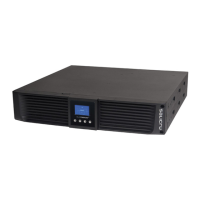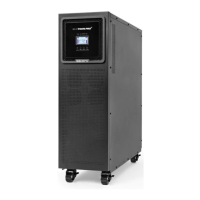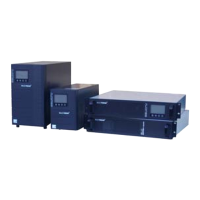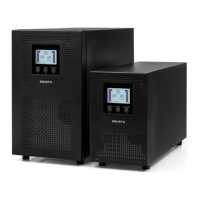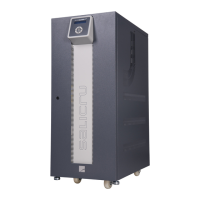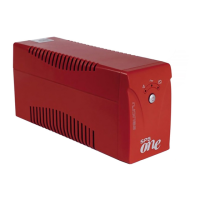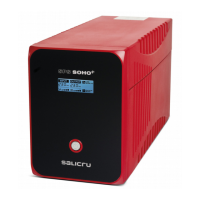Do you have a question about the Salicru SLC TWIN RT2 and is the answer not in the manual?
Guidance on manual usage, including conventions, symbols, and safety instructions.
Detailed explanation of the double-conversion technology and how the UPS functions.
Steps for receiving, inspecting, and verifying the UPS and its package contents upon delivery.
Instructions for starting and shutting down the UPS under various mains voltage conditions.
Guidance on diagnosing and resolving common UPS issues using LCD display information.
Explains the meaning of symbols and conventions used in the manual and on the equipment.
Details on design, manufacturing standards, and EC directives compliance like EMC and safety.
Visual presentation of the device, showing different models and their components.
Explanation of product nomenclature and model identification codes for clarity.
Highlights key features of the SLC TWIN RT2 series UPS, such as online technology and power factor.
Describes the function and placement of an optional isolation transformer.
Details available communication cards for network integration and remote monitoring.
Detailed process for receiving, unpacking, and confirming all included accessories and parts.
Instructions for carefully removing the UPS and accessories from its packaging.
Recommendations for safely moving the UPS to its final installation location.
Guidance on placing the UPS correctly and securing it for stable operation.
Procedure for rotating the control panel for optimal viewing in tower or rack configurations.
Steps for mounting the UPS vertically in a tower configuration using supplied accessories.
Instructions for mounting the UPS with an additional battery module in a tower configuration.
Detailed steps for installing the UPS into a standard 19-inch rack cabinet.
Detailed steps for installing the UPS into a standard 19-inch rack cabinet.
Instructions for rack mounting the UPS along with its battery module.
Guide for mounting the UPS with a PDU in a tower configuration.
Important checks and considerations before connecting the UPS to power sources.
Specific pre-connection checks related to batteries and their internal protection fuses.
Detailed instructions for connecting the UPS power input, including earth conductor connection.
How to connect loads to the 10A IEC connectors for UPS models up to 3 kVA.
Instructions for connecting loads to output terminals or PDU for 4-10 kVA models.
Explanation of N+X redundancy for reliable power structuring in parallel systems.
Steps for connecting and operating multiple UPS units in parallel for redundancy.
Details on RS232 and USB ports for monitoring, firmware updates, and control.
Procedures for ensuring all checks are completed before starting the UPS.
Instructions for starting and shutting down the UPS under various mains voltage conditions.
Instructions for starting and shutting down the UPS under various mains voltage conditions.
Steps for operating multiple UPS units in parallel for enhanced reliability and power.
Procedure for replacing a faulty UPS unit within an operational parallel system without interruption.
Overview of the display's graphical elements and textual information provided.
Lists and explains common messages and status indicators seen on the UPS LCD display.
Lists and explains common abbreviations displayed on the UPS LCD screen.
Explains the different audible alarms, their tones, and muting capabilities.
Instructions for configuring battery capacity (Ah) for extended backup and B1 models.
Explains how to navigate settings menus and modify parameters like output voltage and ECO mode.
Describes the audible alarms for different UPS states and their muting options.
Explains the meaning of the LEDs for various UPS states and modes.
Configuration for setting the output voltage for UPS models.
Configuration for setting the output frequency and mode (UPS/CF).
Instructions for enabling or disabling the ECO energy-saving mode.
Configuration options for enabling or disabling the bypass mode.
Setting the maximum time for battery discharge to protect batteries.
Information on battery care, service life factors, and regular charging requirements.
Crucial safety notes and procedures for installing and replacing UPS batteries.
Details on the warranty terms and conditions for the purchased product.
| Transfer Time | 0 ms |
|---|---|
| Humidity | 0-95% non-condensing |
| Topology | On-line double conversion |
| Output Voltage | 230 V |
| Output Frequency | 50 / 60 Hz |
| Waveform | Sinusoidal |
| Battery Type | Sealed lead-acid maintenance-free |
| Battery Recharge Time | 4 hours to 90% capacity |
| Communication Interface | RS-232, USB |
| Operating Temperature | 0 to 40°C |
| Storage Temperature | -15°C to +50°C |
| Protection | Overload, Short Circuit |
| Certifications | EN 62040-1, EN 62040-2 |
